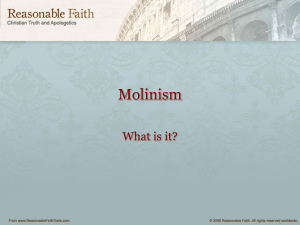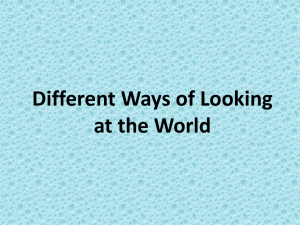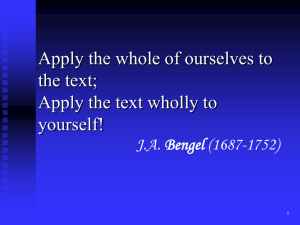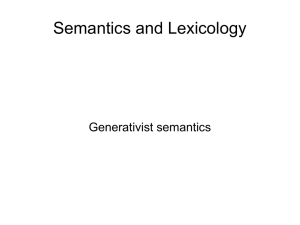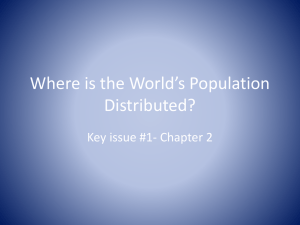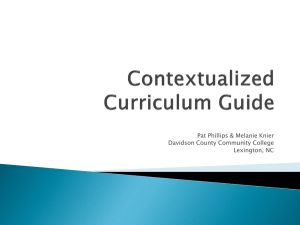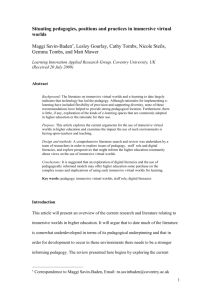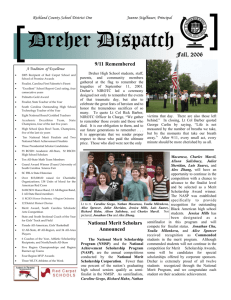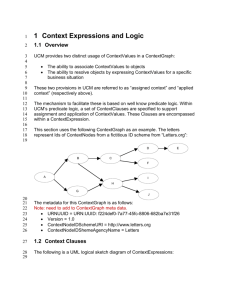Contextualized Vocabulary Learning through a Virtual Learning
advertisement
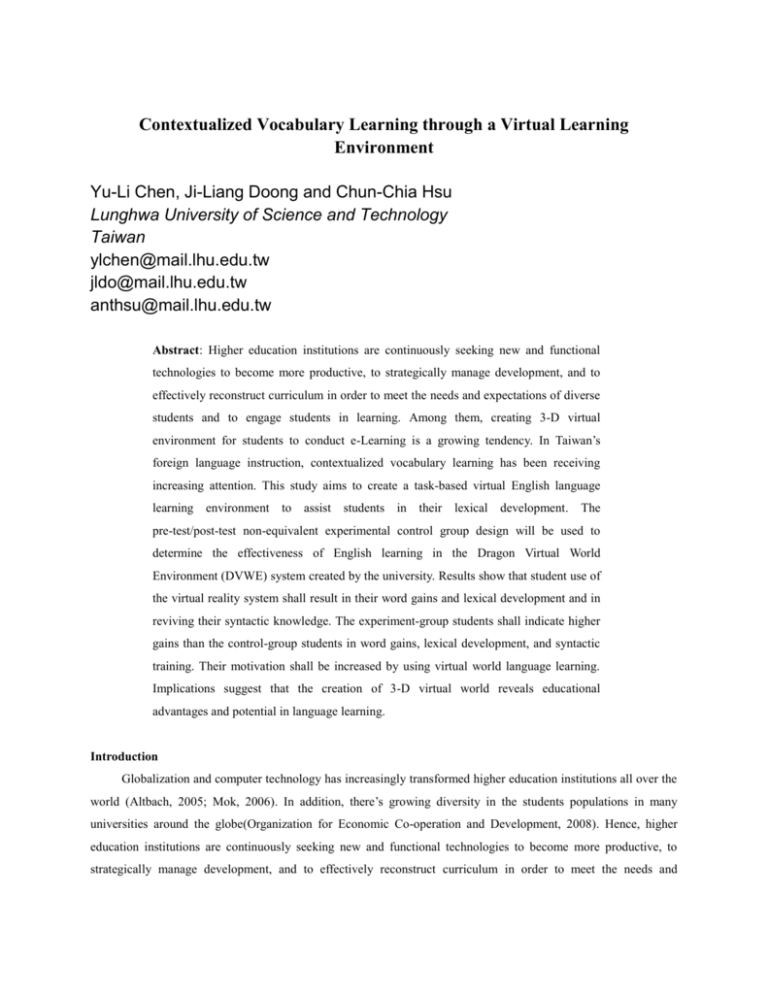
Contextualized Vocabulary Learning through a Virtual Learning Environment Yu-Li Chen, Ji-Liang Doong and Chun-Chia Hsu Lunghwa University of Science and Technology Taiwan ylchen@mail.lhu.edu.tw jldo@mail.lhu.edu.tw anthsu@mail.lhu.edu.tw Abstract: Higher education institutions are continuously seeking new and functional technologies to become more productive, to strategically manage development, and to effectively reconstruct curriculum in order to meet the needs and expectations of diverse students and to engage students in learning. Among them, creating 3-D virtual environment for students to conduct e-Learning is a growing tendency. In Taiwan’s foreign language instruction, contextualized vocabulary learning has been receiving increasing attention. This study aims to create a task-based virtual English language learning environment to assist students in their lexical development. The pre-test/post-test non-equivalent experimental control group design will be used to determine the effectiveness of English learning in the Dragon Virtual World Environment (DVWE) system created by the university. Results show that student use of the virtual reality system shall result in their word gains and lexical development and in reviving their syntactic knowledge. The experiment-group students shall indicate higher gains than the control-group students in word gains, lexical development, and syntactic training. Their motivation shall be increased by using virtual world language learning. Implications suggest that the creation of 3-D virtual world reveals educational advantages and potential in language learning. Introduction Globalization and computer technology has increasingly transformed higher education institutions all over the world (Altbach, 2005; Mok, 2006). In addition, there’s growing diversity in the students populations in many universities around the globe(Organization for Economic Co-operation and Development, 2008). Hence, higher education institutions are continuously seeking new and functional technologies to become more productive, to strategically manage development, and to effectively reconstruct curriculum in order to meet the needs and expectations of diverse students and to engage students in learning. Among them, creating virtual environment for students to conduct e-Learning is a growing tendency (Inman, Wright, & Hartman, 2010) as contemporary students are recognized as ‘Net generation’ (Sandars & Morrison, 2007) or ‘Digital Natives’ (Bayne & Ross, 2011; Prensky, 2003) and many university students use social networking such as Twitter and Facebook to communicate (Ohler, 2010; Thomas, 2011). As educational potential of virtual worlds is gradually being recognized (Savin-Baden, 2010; Zhang, 2010), educators in various field can consider the pedagogical opportunities of immersive learning spaces for student learning. The value of virtual learning environment are threefold: 1) realization and feasibility of distance and remote learning (Hobbs, Brown, & Gordon, 2006); 2) facilitation of sharing of information and knowledge 3) enhancement of learning by doing (Wagner & IP). Virtual worlds provide an online immersive learning environment where students can participate, explore, interact and have fun and hence construct their own knowledge(Dreher, Reiners, Dreher, & Dreher, 2009). They allow real time and synchronous communication, active learning, experiential learning, and cooperative/collaborative learning (Schiller, 2009). In essence, such learning environment is learner-centered and contextualized compared to the traditional bricks and mortars where students learn passively in a decontextualized environment (Ellis & Anderson, 2011). In Taiwan, university students’ linguistic competence, particularly English has long been emphasized. English Language professionals have endeavored to enhance students’ English language proficiency level by incessantly trying innovation including technology use such as computer-mediated communication (Huang, 2009) and blog writing (Ching, 2012). As some of the features in virtual learning environments such as role playing fits with the instructional strategies of language learning (Penfold, 2009), virtual learning environments can be created and built to provide an alternative approach to language learning and to meet the needs and characteristics of contemporary students (Bayne & Ross, 2011). Vocabulary is essential to foreign language acquisition, yet word gains and lexical development of learners tend to vary from individual to individual, prompting scholars into considering factors hitherto addressed only inadequately. These factors range from affectivity, cognitive intensiveness, metacognitive awareness, etymological knowledge, to contextualisation. Scholars are mostly of the consensus that vocabulary learning is a gradual accumulative process involving considerable investments of time and efforts and transference from short-term memory into long-term memory plays a pivotal role in vocabulary learning, While the factors cast new light on the true nature of vocabulary learning, another emergent question suggests that vocabulary learning should not be viewed as an individual aspect of language acquisition detached from other aspects, such as phonology, syntax and morphology. Accordingly, the purpose of this study is to create a task-based virtual language learning environment to assist students in their lexical development in the English for general purposes (EGP) course “English for Daily Life: Shopping English” . Literature review Virtual worlds (VW) are computer-based simulated environments where users can use and create objects and can interact with one another. In the interactive environments, users take the form of avatars and appear as textual, two-dimensional, or three-dimensional representations (Wikipedia, 2012). VW provide an online immersive learning environment where students can participate, explore, interact and have fun and hence construct their own knowledge (Dreher et al., 2009). Savin-Baden (2010) defines it as “a social medium where informality, ingenuity and wit are valued” (p.10). As more empirical research studies on the impact of virtual environment on learning are suggested to be done in higher education(Inman et al., 2010), the value and meaning of virtual world learning environment should be considered. The educational advantages and potentials of virtual world learning environments are revealed in various studies. Ward (2010) designed activities in a virtual world SL with the aim to introduce the concept of avatar-based marketing and for students to evaluate the potential of SL as a marketing communication tool. Students enjoyed the new approaches to learning and felt it had aided their understanding. Wang and Braman (2009) proposed that the immersive nature of virtual environment can provide students a sense of real world experience and it also allows students to actively explore in understanding the content instead of just listening to the lectures or watching video. Kalyuga (2007) found that virtual worlds are highly interactive in that learners can experiment, explore, select personalized task and receive dynamic feedback. Darbey (2011) explores the potential of a VW to support guidance counselors’ preparation for a Teacher Professional Development (TPD) program. The results of the study demonstrated that VWs have huge potential for providing TPD and can support an action research approach. The creative aspects of virtual worlds have a great potential impact on language learning. Virtual worlds offer students the opportunity to interact in the target language. It can provide authentic context for students to create, share and develop in their field of study. The explorations of virtual worlds arouse students’ excitement; thus stimulates students’ motivation in learning, which is quite different from the traditional language learning context and is meaningful for the contemporary net generation students. The study A mixed-method study will be employed. Qualitative data collection will focus on student observation and focus group interviews whereas quantitative data collection will be collected from the pre-and-post assessment and a questionnaire survey. The pre-test/post-test non-equivalent experimental control group design will be used to determine the effectiveness of the DVWE system. Students in the control groups will take the pre-and-post assessment as well for comparison of the results. Participants Participants in this study will include students from the Department of Applied Foreign Languages in a technological university. Two classes are purposively selected, one of which has approximately 30 gender-matched students and will be assigned to use the DVWE system created by the university, while the other class will be considered control group, and will only partake in taking the pre-and-post intervention assessments. Process of Producing Digital Teaching Materials In the process of producing digital materials for teaching, there are 8 main steps. First is the concept, or the main idea, of the lesson. This includes writing the script, identifying the audience, and establishing the need of the user. Next, the storyboard is set up with visual slides and a written script depicting the story. The third step is focused on the function, in which the feasibility, function planning, and working schedule are confirmed. The fourth step is the element in which materials for the lesson plan, plans for the operations, and the user interface are produced. The fifth step is programming and it includes three sections. First, the art and design department designs the characters, sets, user interface, and 3D animation. Second, the program development department develops the system architecture, import component integration, and component control. The third section is the sound and music creation, which includes the background music and sound effects for the animation. The sixth step in producing digital materials is the testing phase, followed by the release of the prototype. If any problems are encountered in the prototype, corrections are made and the prototype is retested again. Lastly, once everything runs smoothly, the digital course materials are released. Computer Software Application and Game Development Engine Integration Graphic design software, such as Adobe Illustrator CS6, Adobe Photoshop CS6, can be used for drawing objects or materials. The materials can then be imported into Adobe Flash CS6, an animation software, and Action script 3.0 can be used to write the program code to design an interactive interface for teaching materials. The next step is to import the materials into Autodesk MAYA, a 3D animation software, to further combine with the action database to create 3D characters and objects. All the materials can then be imported into Unity 3.5, a game development engine software. Results and Discussion EFL teachers are keenly aware of the fact that words can be best learned when they occur in corresponding context. DVWE aims to help students learn high-frequency items by seeing and listening to them in meaningful contexts. While engaged in the virtualized world of DVWE, they experience not only visual but also tactile stimuli in learning vocabulary. Contextual learning is instrumental for student to internalize syntactic rules and structures. As students can see words in the dialogues between characters, they can also initiate the parsing process each time they use DVWE. Their engagement enhances concentration on sentence structures, prompting them into analyzing elements in the sentence, deciding on their grammatical roles and validity and then reviving their syntactic knowledge. As words are also played to them, auditory stimuli further help them to consolidate orthographical knowledge as word forms and their corresponding sound patterns can be cognitively matched. Conclusion Contextualized lexical learning benefits students more than decontextualized one in a formal setting. Progress made can be noted in the aspects of word usage, word retention, syntactic training as well as orthographical consolidation. Student’s motivation shall be increased by using virtual world language learning. Implications suggest that the creation of 3-D virtual world-DVWE reveals educational advantages and potential in language learning. References Altbach, P. G. (2005). Globalization and the university: Myths and realities in an unequal world. In The NEA 2005 Almanac of Higher Education (pp. 63-74). Washington, DC: National Education Association. Bayne, S., & Ross, J. (2011). 'Digital native' and 'digital immigrant' discourses; A critique. In S. Bayne & R. Land (Eds.), Digital Differences: Perspectives on Online Education (pp. 159-170). Rotterdam: Sense Publishers. Ching, G. S. (2012). Blog assisted learning: Experiences in learning Business English vocabularies. International Journal of Research Studies in Educational Technology, 1(1), 3-12. Darbey, L. (2011). An exploration of the potential of a virtual world to support teachers' preparation for teacher professional development using an action research approach: National Centre for Guidance in Education. Dreher, C., Reiners, T., Dreher, N., & Dreher, H. (2009). Virtual worlds as a context suited for information systems education: Discussion of pedagogical experience and curriculum design with reference to Secon Life. Journal of Information Systems Education, 20(2), 211-224. Ellis, M., & Anderson, P. (2011). Learning to teach in second life: A novice adventure in virtual reality. Journal of Instructional Pedagogies, 6(September), 1-12. Hobbs, M., Brown, E., & Gordon, M. (2006). Using a virtual world for transferable skills in gaming education. Innovation in Teaching and Learning in Information and Computer Sciences, 5(3), 1-13. Huang, L.-j. (2009). Language use in asynchronous computer-mediated communication in Taiwan. Australian Review of Applied Linguistics, 32(2), 12.11-12.22. Inman, C., Wright, V. H., & Hartman, J. A. (2010). Use of Second Life in K-12 and higher education: A review of research. Journal of Interactive Online Learning, 9(1), 44-63. Kalyuga, S. (2007). Enhancing instructional efficiency of interactive e-learning environments: A cognitive load perspective. Educational Psychology Review, 19(3), 387-399. Mok, K. H. (2006). Education reform and education policy in East Asia. New York, NY: Routledge. Ohler, J. B. (2010). Digital community digital citizen. Thousand Oaks, California, USA: Corwin. Organization for Economic Co-operation and Development. (2008). Education at a glance: OECD indicators. Paris: Organization for Economic Co-operation and Developmento. Document Number) Penfold, P. (2009). Learning through the World of Second Life - A Hospitality and Tourism Experience. Journal of Teaching in Travel & Tourism, 8(2-3), 139-160. Prensky, M. (2003). Digital game-based learning. ACM Computers in Entertainment, 1(1), 1-4. Sandars, J., & Morrison, C. (2007). What is the Net Generation? : The challenge for future medical education. Medical Teacher, 29(2/3). Savin-Baden, M. (2010). A Practical Guide to using Second Life in Higher Education. New York, NY Open University Press. Schiller, S. Z. (2009). Practicing learner-centered teaching: Pedagogical design and assessment of a Second Life project. Journal of Information Systems Education, 20(3), 369-381. Thomas, M. (2011). Digital education: Opportunities challenges, and responsibilities. New York, New York: Macmillan. Wagner, C., & IP, R. K. F. (2009). Action learning with Second Life - A pilot study. Journal of Information Systems Education, 20(2), 249-258. Wang, Y., & Braman, J. (2009). Extending the classroom through Second Life. Journal of Information Systems Education, 20(2), 235-247. Ward, J. (2010). The avatar lecturer: Learning and teaching in Second Life. Marketing Intelligence & Planning, 28(7), 862-881. Wikipedia. (2012). Virtual world. Retrieved August 2, 2012, from http://en.wikipedia.org/wiki/Virtual_world Zhang, C. (2010). Using virtual world learning environment as a course component in both distance learning and traditional classroom: Implications for technology choice in course delivery. Paper presented at the Proceedings of the Southern Association for Information Systems Conference, March 26th-27th, Atlanta, GA, USA


